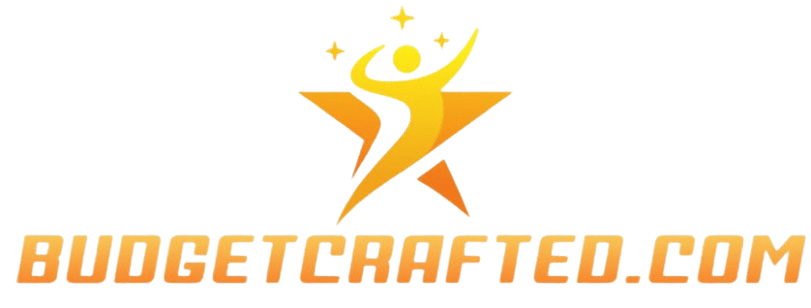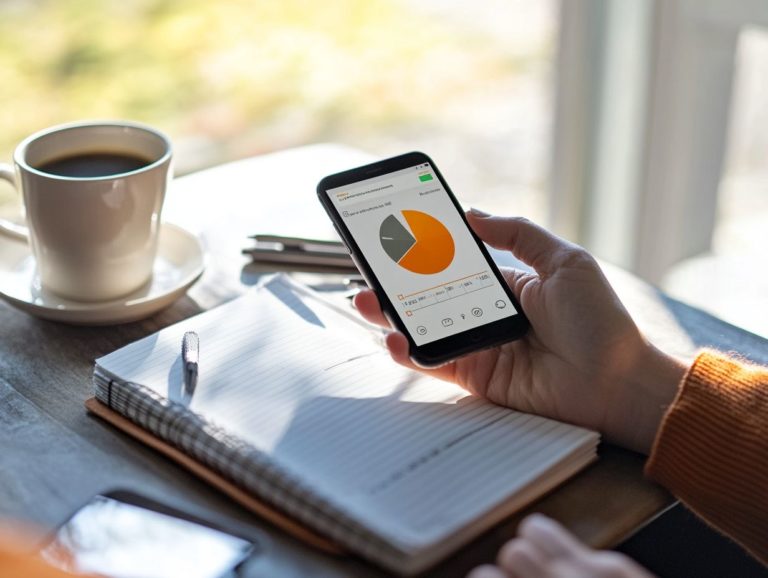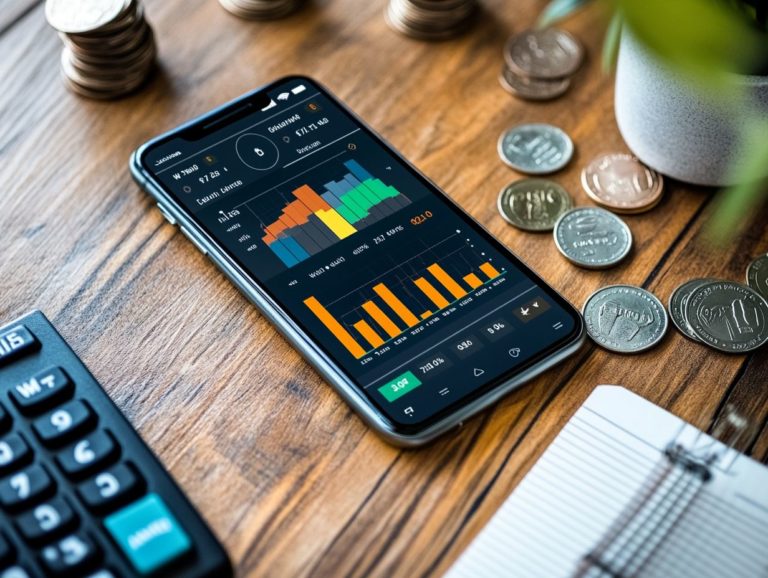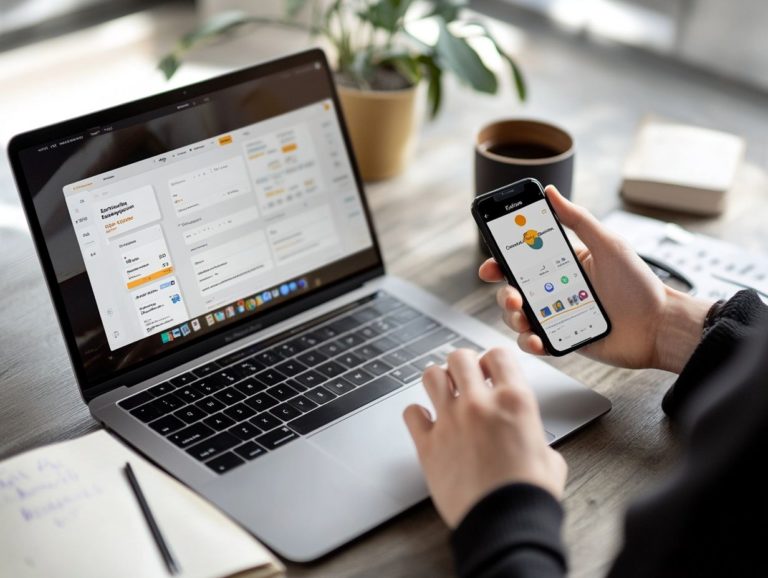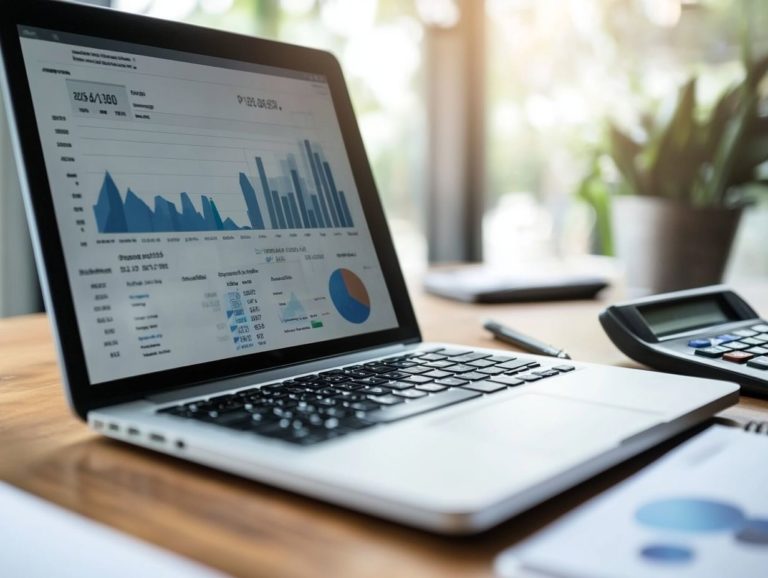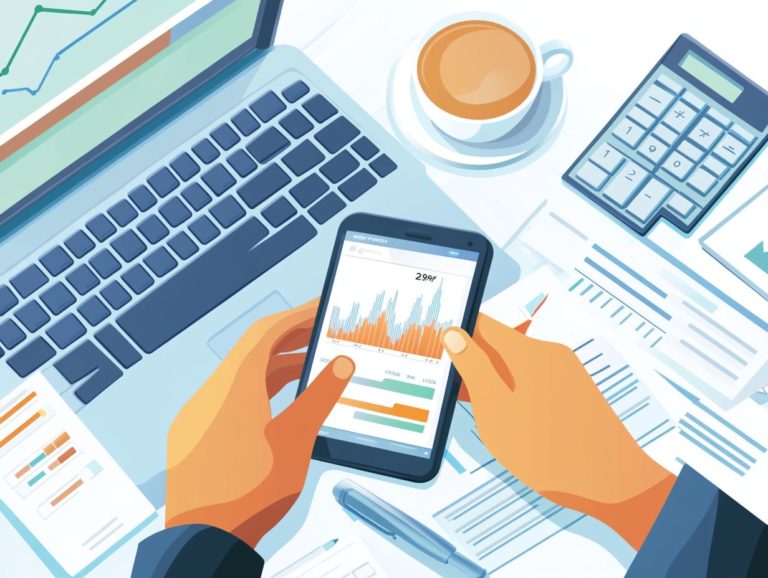Comparing Popular Budgeting Tools: A Guide
Taking charge of your finances is not just important it s possible! In today s fast-paced world, managing your finances effectively is more essential than ever. Utilizing budgeting tools can empower you to take control of your spending, save for future aspirations, and alleviate financial stress.
This article delves into various types of budgeting tools whether manual or automated, free or paid spotlighting some of the most popular options available. You ll discover insights on selecting the right tool tailored to your needs and tips to maximize their benefits.
Get ready to transform your financial journey like never before!
Contents
- Key Takeaways:
- Types of Budgeting Tools
- Free vs. Paid Tools
- Popular Budgeting Tools on the Market
- Overview and Features of Each Tool
- How to Choose the Right Budgeting Tool for You
- Factors to Consider
- Tips for Effectively Using Budgeting Tools
- Maximizing the Benefits of Budgeting Tools
- Frequently Asked Questions
- What are some popular budgeting tools that can help me manage my finances?
- Can I access these budgeting tools on my mobile device?
- Do these budgeting tools have a cost?
- Which budgeting tool is best for beginners?
- What features should I look for when comparing budgeting tools?
- Can I switch between budgeting tools if I am not satisfied with my current one?
- Frequently Asked Questions
Key Takeaways:
- Automated budgeting tools offer convenience and accuracy, while manual tools provide a hands-on approach. Consider your budgeting style when choosing between the two.
- While paid budgeting tools may have more advanced features, there are many free options available that can still help you manage your finances effectively.
- When choosing a budgeting tool, consider factors such as cost, features, user-friendliness, and compatibility with your financial goals and needs.
Discover Budgeting Tools: Your Key to Financial Success!
Budgeting tools are essential instruments crafted to help you manage your finances efficiently. They provide valuable financial insights, track your transactions, and facilitate effective money management strategies.
With the rise of technology, these tools have evolved to offer a myriad of features tailored to meet diverse financial needs everything from monitoring your credit score to understanding your spending habits and aligning with your financial goals.
Typically, these tools come equipped with features like expense tracking, automated budgeting, and comprehensive reporting capabilities, making them invaluable resources for anyone keen to enhance their financial literacy. You can easily create categories for various expenses, set limits, and receive alerts as you near your budget thresholds, enabling you to manage your financial situation proactively.
Many budgeting tools also integrate seamlessly with your bank accounts and financial institutions, providing real-time updates on your spending. This ensures you maintain a comprehensive view of your financial health. Such transparency enables more knowledge-based decision-making, helping you prioritize savings, investments, and debt repayment.
Ultimately, this leads to greater financial stability and peace of mind.
Types of Budgeting Tools
You ll find a range of budgeting tools available in the market, each tailored to meet distinct financial management needs. These tools can be broadly categorized into manual options and automated budgeting apps.
Each type offers unique features and user experiences, enabling you to effectively reach your financial goals.
Manual vs. Automated Tools
Manual budgeting requires you to track your expenses and income using traditional methods, such as spreadsheets or even good old pen and paper.
Automated budgeting apps streamline this process effortlessly by linking directly to your financial accounts and automatically categorizing transactions. This makes it much simpler for you to implement strategies like a budgeting method where you allocate every dollar of your income to expenses, savings, or investments, leaving you with zero at the end of the month.
While manual budgeting offers a sense of control and allows for detailed oversight enabling you to customize every entry and engage deeply with your finances it also presents challenges, such as being time-consuming and prone to errors.
In contrast, automated tools provide a user-friendly interface that quickly compiles data, integrates real-time updates across various bank accounts, and categorizes your spending with ease.
For example, you can track your monthly dining expenses without the hassle of manually entering each transaction. This automated approach not only eliminates the tedious tasks associated with budgeting but also enhances your overall financial awareness, allowing you to concentrate on achieving your monetary goals more effectively.
Start today, and watch your financial confidence soar!
Free vs. Paid Tools
When exploring budgeting tools, you can choose between free options that provide basic functionalities or invest in paid apps that offer extra tools. The premium versions often include in-depth financial insights, higher user ratings, and tailored budgeting strategies.
If your financial needs are straightforward, free tools might meet your requirements. They provide essential features like income tracking and expense categorization. However, you may find that these tools’ limitations can hinder your ability to achieve more specific financial goals.
On the other hand, paid applications typically come loaded with premium features, such as automatic expense tracking, personalized financial advice, and seamless integration with your bank accounts for real-time updates. User ratings consistently reflect satisfaction with the intuitive interfaces and comprehensive reporting these paid versions provide, showing that investing in these tools can greatly elevate your budgeting experience and financial literacy.
Popular Budgeting Tools on the Market
In the world of budgeting tools, several standout applications capture attention with their unique features and user-friendly interfaces. Explore Mint, YNAB, EveryDollar, Simplifi, PocketGuard, Goodbudget, and Monarch.
Each of these tools offers distinct functionalities designed to help you reach your financial goals while providing valuable insights into your spending habits.
Overview and Features of Each Tool
Each budgeting tool has its own unique set of features tailored to your financial journey. For instance, Mint offers free budgeting capabilities along with extra tools designed for advanced users, while YNAB emphasizes zero-based budgeting, which means assigning every dollar a specific job to maximize its use. Additionally, you can explore personal budget templates that help streamline your finances. Tools like PocketGuard provide a clear overview of your spending habits.
These distinctions not only address diverse financial needs but also significantly enhance your user experience. Take Mint, for example; its intuitive interface seamlessly integrates with your financial accounts, automatically updating spending reports and allowing you to track your financial goals with ease.
YNAB encourages a proactive approach to budgeting by assigning every dollar a job, beneficial if you aim to gain control over your finances. Meanwhile, PocketGuard simplifies your financial life by showing you exactly how much is left after accounting for bills, goals, and necessities, making it ideal for anyone wanting a quick snapshot of their financial health.
How to Choose the Right Budgeting Tool for You
Choosing the right budgeting tool can transform your financial future! Start by understanding your personal financial goals. Assess your preferences and identify which budgeting strategies resonate with your lifestyle.
This thoughtful approach enables you to manage your finances more effectively, guiding you toward achieving your objectives.
Factors to Consider
When selecting a budgeting tool, consider several important factors: the features it offers, user ratings, how well it aligns with your financial goals, and your personal preferences for managing transactions and expenses. Learning how to make budgeting tools work for you can also enhance your experience.
One key aspect to keep in mind is ease of use; a straightforward interface encourages consistent tracking of your finances. For instance, tools like Mint provide user-friendly dashboards that simplify expense management.
The tool should also adeptly track transactions. Features that allow for automatic syncing with your bank accounts can greatly reduce the effort and errors associated with manual entry.
Don t forget about compatibility with various budgeting methods. Some may prefer the envelope system, while others lean toward zero-based budgeting. For example, YNAB is well-regarded for its flexible structure, seamlessly accommodating different budgeting techniques.
Ultimately, evaluating how well these features resonate with your individual needs can enhance your budgeting experience significantly.
Tips for Effectively Using Budgeting Tools
To effectively utilize budgeting tools, adopt a strategic approach that emphasizes setting clear financial goals.
You should regularly review your spending habits to identify areas for improvement. Fully leveraging the features of your chosen budgeting app will enable you to gain actionable financial insights, positioning you for greater financial success.
Maximizing the Benefits of Budgeting Tools
To truly harness the power of budgeting tools, actively engage in money management practices and consistently track your expenses. Align your budgeting strategies with your long-term financial goals.
Monitoring your spending habits helps you identify patterns that might lead to overspending in areas like dining out or online shopping. Use features within your budgeting tool, such as setting custom categories, to organize your expenses and gain clarity on your funds. For instance, creating distinct categories for groceries, utilities, and entertainment gives you a clearer snapshot of your overall financial health.
Establishing specific financial goals whether saving for a dream vacation or paying down debt allows you to see real-time progress toward these milestones. This structured approach keeps you accountable and motivated to reach your financial goals!
Frequently Asked Questions
-
What are some popular budgeting tools that can help me manage my finances?
Some popular budgeting tools include Mint, You Need a Budget (YNAB), Personal Capital, EveryDollar, Goodbudget, and Tiller Money.
-
Can I access these budgeting tools on my mobile device?
Yes, most budgeting tools have mobile apps available for download on both iOS and Android devices.
-
Do these budgeting tools have a cost?
Some budgeting tools may have a subscription fee, while others offer a free version with limited features. Research the cost and features before choosing a budgeting tool.
-
Which budgeting tool is best for beginners?
Many people find Mint to be a good choice for beginners as it is user-friendly and offers a comprehensive overview of your finances. However, consider your specific needs and preferences when choosing a budgeting tool.
-
What features should I look for when comparing budgeting tools?
Important features to consider include the ability to link multiple bank accounts and credit cards, customizable budget categories, goal-setting options, and detailed reporting and analysis.
-
Can I switch between budgeting tools if I am not satisfied with my current one?
Yes, you can switch between budgeting tools at any time. Research and compare different options to find the best fit for your needs.
Start using a budgeting tool today and take control of your finances!
